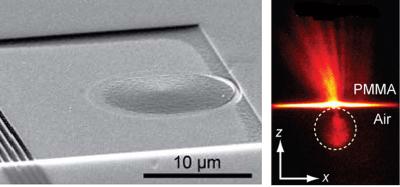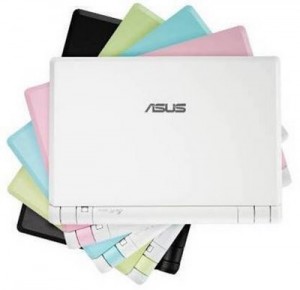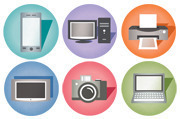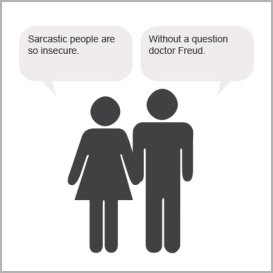Below was summarized from my googling search to define how netters classify sarcasm in term of attitude. Hope this pretty useful for anyone who thinks upfronting is the only negativity so they use another form to spread the negativity?
“Sarcasm is for cowards. The touch of humor in sarcastic comments can hide criticisms far too aggressive to be spoken plainly. If you can’t bring yourself to directly say what you really mean, you shouldn’t say it at all.“
Attitude is like food; it comes in all different kinds. Like fruits and vegetables, some kinds of attitude are good for you. Like double-deep-fried peanut butter-filled Twinkies, some are bad for you. For the most part, you can label attitudes as “positive” and “negative.”
One example of a positive attitude is cheerfulness, being in a good mood and pleasant to be around. Another is optimism, which is looking for the good side in situations and people. Positive attitudes are valuable gifts that can improve your life and the lives of those around you. But like some valuable gifts, they can be hard to find. Honestly, I’m baffled by how some people can be so optimistic! Do you have to watch Pollyanna 10 times in a row before becoming an optimistic person?
Negative attitudes hurt you and and the people in your life. Sarcasm is a type of negative attitude where you use mocking language to hurt someone. Pessimism is the opposite of optimism, so you’re expecting the worst in people and situations. And you know what can really leave a bitter taste in your mouth? Bitterness! That’s a type of anger or resentment toward something that happened to you (or you think happened to you).
Here are ten reasons for you to put the sarcasm aside.
- First, the practical: sarcasm is ambiguous. A sarcastic message depends heavily on tone of voice, body language and other nonverbal cues to be properly understood. The true meaning of a sarcastic message is easily lost over the phone–and you can forget about sarcastic comments being properly understood in written communication. Sarcasm often goes unnoticed without the change in inflection or raised eyebrow to signal its presence. And if you miss those cues, sarcastic remarks don’t make any sense.
- Sarcasm translates poorly. E SL teachers are taught to never use sarcasm: it’s just not understood by their students.
- Sarcasm is a defense mechanism. It’s not a very good one, because of the inherent negative nature of sarcasm. If you need a positive defense mechanism, make it laughter. (Just make sure it’s friendly laughter.)
- Sarcasm is cynical. Do you want to be known as a person who is “scornfully and habitually negative”? That’s the dictionary definition of a cynic. Sarcasm is both a product and reinforcer of negative thinking. Find some happier thoughts. Don’t wallow in negativity.
- Sarcasm is negative by its very nature. There’s a reason the saying goes “accentuate the positive.” Nothing good comes from sarcasm.
- Sarcasm is mean and can be used as a veil for truly hurtful criticism. The element of humor takes the edge off a bit, but it’s still mean. Don’t be a bully; drop the sarcasm.
- Sarcasm is for cowards. The touch of humor in sarcastic comments can hide criticisms far too aggressive to be spoken plainly. If you can’t bring yourself to directly say what you really mean, you shouldn’t say it at all.
- Sarcasm is the lowest form of wit, says Oscar Wilde. It’s not funny; it doesn’t make you seem witty. Take Emily Post’s advice instead: “As a possession for either man or woman, a ready smile is more valuable in life than a ready wit.”
- Sarcasm is a means of judging others. Do you really need to belittle others to make yourself look better? Don’t be the jerk with the superiority complex. Use kind words instead.
- Sarcasm wastes words that could be put to better use. Kind words are the best thing we can give another person. Sarcasm trades kindness for cruelty. It serves no higher purpose; it builds no one up. Silence is far preferable to sarcasm, but kind words are better still.
References :
http://www.ehow.com/info_12142789_deal-sarcastic-coworkers.html
http://modernmrsdarcy.com/2011/03/you-can-kick-the-sarcastic-habit/
http://www.americanchronicle.com/articles/view/130479
Here’s something i found on Robin Sharma’s page which is quite encouraging for us to read. Hope you find this useful for you.
15 Ways For You To Do Your Best Work
- Do your best work by challenging the way you did things yesterday.
- Do your best work by allowing your passion to see the light of day.
- Do your best work by becoming part of the solution versus growing the problem.
- Do your best work by expecting nothing less than you playing at world-class.
- Do your best work by giving away the credit (especially when you crave it)
- Do your best work by practicing your skills so you become a virtuoso.
- Do your best work by releasing excuses and doing important things.
- Do your best work by getting up when you’ve been knocked down.
- Do your best work by keeping your promises; to others and to yourself.
- Do your best work by showing integrity.
- Do your best work by delivering more value than anyone could ever expect from you.
- Do your best work by making time to refill your well.
- Do your best work by having a strong foundation at home.
- Do your best work by becoming as fit as a pro athlete.
- Do your best work by doing work that makes a difference and inspires others to do the same.
As Chuck Palahniuk once said: “The goal isn’t to live forever. The goal is to create something that will.”
Keep Leading Without a Title.
Gender Guesser
The words you use can disclose identifying features. This tool attempts to determine an author’s gender based on the words used. Submitted text is evaluated based on two types of writing: formal and informal. Formal writing includes fiction and non-fiction stories, articles, and news reports. Informal writing includes blog and chat-room text. (Email can be formal, informal, or some combination.) You should view the results based on the appropriate type of writing.
Here’s the screenshot for male writing result :
A few quick notes:
- The system generates a simple estimate (profiling). While Gender Guesser may be 60% – 70% accurate, it is not 100% accurate. This is better than random guessing (50%), but should not be interpreted as “fact”. In particular, men should not be offended if it says you write like a girl.
- People write differently in different forums. For example, a single writing sample may appear MALE for informal writing but test as FEMALE for formal writing. Be sure to interpret the results based on the appropriate writing style. (These notes, for example, are more informal/blog than formal/non-fiction.)
- Many factors can impact the interpretation from any single person’s writing. The content, knowledge of the material, age of the author, nationality, experience, occupation, and education level can all impact writing styles. For example, a woman who has spent 20 years working in a male-dominated field may write like her co-workers. Similarly, professional female writers (and experienced hobbyists) frequently use male writing styles. Gender Guesser does not take any of these factors into account.
- Email can blur the lines between formal and informal writing styles. An informal email from a manager may have traces of formality, and a formal email from a 12-year-old is likely to be informal compared to a letter from a 40-year-old. Do not be surprised if email messages sent to public forums test incorrectly — when writing for an audience, people commonly use informal words, phrases, and slang within a formal writing style.
- Quotations, block quotes, and included text usually carries the gender from the initial author. Be sure to remove quoted text from any pasted content. Also, significant changes from a copy-editor can result in a different gender analysis. (A male editor may make a female author’s news article appear MALE or as a Weak MALE.)
- Lyrics, lists, poems, and prose are special writing styles. This tool is unlikely to classify these texts correctly.
- The system needs a paragraph or two of text in order to observe word repetition. A good sample should have 300 words or more. Fewer words can lead to more variation in accuracy, and a single sentence is unlikely to generate an accurate result. Pasting the same text multiple times will not change the results!
- People tend to write with consistent styles. If the system misclassifies a particular author, then other writings by the same author will likely be misclassify the same way.
If you’d like to try, you can go to : Guess the gender author from his/her writing
All this time, We may only focus on utilities that maximize the use of RAM on our computer without paying too much attention to the CPU usage process. The CPU usage process that also affects the computer response and the loading process as well.
Even if you got a big RAM installed in your computer, When a CPU process-consuming such as the process of Windows Desktop Manager service (to enable themes, without this a theme is not running) or the Windows idle process; The process we can not stop but greatly affects the CPU usage, Our computer will become slower in response and most of the time got lagged.
Process Tamer solves this problem by identifying such these degenerate conditions and temporarily reducing the priority of the offending processes in order to allow your system to respond to other requests. Stop being a victim to an overloaded cpu – let Process Tamer keeps your system responsive no matter what you’re doing.
You’ll see a balloon tooltip in your system tray whenever Process Tamer adjusts or restores the priority of an application, so you’ll always know what it’s doing and why.
The new version 2 release includes a new separate standalone configuration tool which lets easily setup exclusion rules, manually adjust process priorites, and more, without affecting the efficiency and resource use of the resident system tray tool.
Download this application for personal use : Link is in the main homepage HERE.
A Japanese researchers team has developed a reagent that can make cancer cells glow and become visible to the naked eye, an advance that could help surgeons more accurately distinguish between cancerous and healthy tissue, the medical journal Science Translational Medicine reported Wednesday.
Chemical reagent that makes the cells glow in a rat’s stomach filled with ovarium cancer cells.
Within minutes, the sprayed reagent, developed by Yasuteru Urano, a chemical biology professor at the University of Tokyo, and Hisataka Kobayashi, chief scientist at the U.S. National Institutes of Health, can highlight carcinoma smaller than 1 mm, which magnetic resonance imaging and other tools cannot detect. The team’s attention was drawn to an enzyme on the cell surface that works like scissors to cut off glutamic acid from glutathione, and the researchers created a molecule that glows green only when the glutamic acid is cut off.
Kobayashi (left) and Urano (top-right)
The Japanese team succeeded in making cancer cells glow more than 20 times brighter than regular cells by spraying the reagent on the abdomen of mice. Their abdomens had been implanted with human ovarian cancer cells, the team said. The team is still testing to see whether the fluorescent molecule could be poisonous to cells, but they said no hazardous effects have been detected so far even by using large amounts of the reagent. They aim to put the reagent to practical use within a few years as an easy and low-cost tool at hospitals to find cancers and remove them without overlooking small carcinoma. Cancer is the largest cause of death among Japanese, followed by heart failure and cerebral vessel disease.
Fantastic !

If you haven’t been to a mall recently, you may not be aware that remote control helicopters are the hot new item for 2011. They are showing up everywhere these days, and there is good reason for it. The technology that they use has finally graduated to the mainstream.
Let’s take a quick look at whats available out there and what the differences are between a $25 helicopter and a $200 helicopter.
Micro Helicopters are the least expensive of the bunch. They are remote controlled via infra red and are very forgiving for any new pilot. They are of the co-axial style, which means that they have two counter rotating main rotor assemblies to make them very stable in flight. The micro heli is also very forgiving with crashes and what are called blade strikes. (when the blade hits something that won’t give) If you are buying for an 8 or 10 year old, this is the way to go. The micros usually recharge through a cable from the controller to the unit and can be flown indoors without too much worry for damage to anyone or anything.
Read Full Article RC Helicopters – “Learning To Fly”



 On left is a scanning electron micrograph of a plasmonic Luneburg lens on a gold film. On the right, fluorescence imaging shows intensity of the SPPs propagated by the Luneburg lens (dotted circle). X marks the launching position of the electron beam and Z is the direction in which the SPPs propogate. (Image courtesy of Zhang group)
On left is a scanning electron micrograph of a plasmonic Luneburg lens on a gold film. On the right, fluorescence imaging shows intensity of the SPPs propagated by the Luneburg lens (dotted circle). X marks the launching position of the electron beam and Z is the direction in which the SPPs propogate. (Image courtesy of Zhang group)
They said it could be done and now they’ve done it. What’s more, they did it with a GRIN. A team of scientists with the U.S. Department of Energy (DOE)’s Lawrence Berkeley National Laboratory (Berkeley Lab) and the University of California, Berkeley, have carried out the first experimental demonstration of GRIN – for gradient index – plasmonics, a hybrid technology that opens the door to a wide range of exotic optics, including superfast computers based on light rather than electronic signals, ultra-powerful optical microscopes able to resolve DNA molecules with visible light, and “invisibility” carpet-cloaking devices.
Working with composites featuring a dielectric (non-conducting) material on a metal substrate, and “grey-scale” electron beam lithography, a standard method in the computer chip industry for patterning 3-D surface topographies, the scientists have fabricated highly efficient plasmonic versions of Luneburg and Eaton lenses. A Luneburg lens focuses light from all directions equally well, and an Eaton lens bends light 90 degrees from all incoming directions.
“This past year, we used computer simulations to demonstrate that with only moderate modifications of an isotropic dielectric material in a dielectric-metal composite, it would be possible to achieve practical transformation optics results,” says Xiang Zhang, who led this research. “Our GRIN plasmonics technique provides a practical way for routing light at very small scales and producing efficient functional plasmonic devices”.
Zhang, a principal investigator with Berkeley Lab’s Materials Sciences Division and director of UC Berkeley’s Nano-scale Science and Engineering Center (SINAM), is the corresponding author of a paper in the journal Nature Nanotechnology, describing this work titled, “Plasmonic Luneburg and Eaton Lenses.” Co-authoring the paper were Thomas Zentgraf, Yongmin Liu, Maiken Mikkelsen and Jason Valentine.
GRIN plasmonics combines methodologies from transformation optics and plasmonics, two rising new fields of science that could revolutionize what we are able to do with light. In transformation optics, the physical space through which light travels is warped to control the light’s trajectory, similar to the way in which outer space is warped by a massive object under Einstein’s relativity theory. In plasmonics, light is confined in dimensions smaller than the wavelength of photons in free space, making it possible to match the different length-scales linked to photonics and electronics in a single nanoscale device.
“Applying transformation optics to plasmonics allows for precise control of strongly confined light waves in the context of two-dimensional optics,” Zhang says. “Our technique is analogous to the well-known GRIN optics technique, whereas prior plasmonic techniques were realized by discrete structuring of the metal surface in a metal-dielectric composite”.
Like all plasmonic technologies, GRIN plasmonics starts with an electronic surface wave that rolls through the conduction electrons on a metal. Just as the energy in a wave of light is carried in a quantized particle-like unit called a photon, so, too, is plasmonic energy carried in a quasi-particle called a plasmon. Plasmons will interact with photons at the interface of a metal and dielectric to form yet another quasi-particle, a surface plasmon polariton (SPP).
The Luneburg and Eaton lenses fabricated by Zhang and his co-authors interacted with SPPs rather than photons. To make these lenses, the scientists worked with a thin dielectric film (a thermplastic called PMMA) on top of a gold surface. When applying grey-scale electron beam lithography, the scientists exposed the dielectric film to an electron beam that was varied in dosage (charge per unit area) as it moved across the film’s surface. This resulted in highly controlled differences in film thickness across the length of the dielectric that altered the local propagation of SPPs. In turn, the “mode index,” which determines how fast the SPPs will propagate, is altered so that the direction of the SPPs can be influenced.
“By adiabatically tailoring the topology of the dielectric layer adjacent to the metal surface, we’re able to continuously modify the mode index of SPPs,” says Zentgraf. “As a result, we can manipulate the flow of SPPs with a greater degree of freedom in the context of two-dimensional optics”.
Says Liu, “The practicality of working only with the purely dielectric material to transform SPPs is a big selling point for GRIN plasmonics. Controlling the physical properties of metals on the nanometer length-scale, which is the penetration depth of electromagnetic waves linked to SPPs extending below the metal surfaces, is beyond the reach of existing nanofabrication techniques”.
Adds Zentgraf, “Our approach has the potential to achieve low-loss functional plasmonic elements with a standard fabrication technology that is fully compatible with active plasmonics”.
In the Nature Nanotechnology paper, the scientists say that inefficiencies in plasmonic devices due to SPPs lost through scattering could be reduced even further by incorporating various SPP gain materials, such as fluorescent dye molecules, directly into the dielectric. This, they say, would lead to an increased propagation distance that is highly desired for optical and plasmonic devices. It should also enable the realization of two-dimensional plasmonic elements beyond the Luneburg and Eaton lenses.
Says Mikkelsen, “GRIN plasmonics can be immediately applied to the design and production of various plasmonic elements, such as waveguides and beam splitters, to improve the performance of integrated plasmonics. Currently we are working on more complex, transformational plasmonic devices, such as plasmonic collimators, single plasmonic elements with multiple functions, and plasmonic lenses with enhanced performance”.
This research was supported by the U.S. Army Research Office and the National Science Foundation’s Nano-scale Science and Engineering Center.
Posted by: Ethan Source

Image courtesy of Reviewheaven.net
The ‘Asus EEE PC 2G Surf‘ is a sleek netbook designed by ASUS. They say it is Easy to learn, Easy to Work and Easy to play. The Eee stands for these three E qualities of this net book. The Asus Eee PC 2G Surf is manufactured by Pegatron Technology and developed by ASUSTek Computer Inc. This netbook measures 8.86 inch x 6.30 inch x 0.79-1.26 inch and weighs 2.0 lbs. There’s a 4400 mAh Battery of 4-cell that comes with this netbook. There are three versions of this model and they are the 2G, 4G and 8G units. They are available in the following colors, black, white, pink, blue and green. This netbooks comes with a restore disk, driver disk (for Windows installs) and documentation. The Asus Eee PC 2G Surf can be purchased at a starting price of $299.
Specifications
Asus has always promoted the Eee netbook series to be easy to work, easy to learn and easy to play. It has 10/100 Ethernet and 802.11b/g wireless. It comes with a VGA port and an SD Card Slot that supports SDHC. The Celeron-M 800 MHz operates at 571 MHz. System memory of this Eee netbook is at 512MB. There’s a flash memory reader slot whereby users can use an SD memory card to write or read. This netbook comes with a 4400 mAh 4-cell unit that can last for about 2.5 hours. The battery can be upgraded to a 5600 mAh which can last for about 3.5 hours.
Display
The display is a 7-inch LCD monitor that comes with a resolution of 800 x 480 pixels.
View the original article here
 Sometimes, in life, the answers are very apparent, but that is not always the case. The matter of choosing the gear to outfit your office is not always as easily settled as one might think. Is it best to go with a PC or a Mac? Can I really afford the price associated with some of these models? What about the printer? Is the thought of printing the number of pages required in my office really practical given the cost of ink cartridges?
Sometimes, in life, the answers are very apparent, but that is not always the case. The matter of choosing the gear to outfit your office is not always as easily settled as one might think. Is it best to go with a PC or a Mac? Can I really afford the price associated with some of these models? What about the printer? Is the thought of printing the number of pages required in my office really practical given the cost of ink cartridges?
These are the sorts of questions that can arise when trying to make those initial decisions to build an office, or even the decisions regarding replacement of the out of date goods of yesteryear. Another question that many are finding themselves asking today is “Notebook, netbook, or tablet?” Consider this article for information to make that decision easier.
What are my options?
Buying a computer today is nothing like what it was ten years ago. First of all, walking out of the store with a computer might only mean carrying a small, traditional plastic bag. After all, many of the tablets and even some notebooks are so thin and light weight today that they could easily fit in a woman’s purse and be carried without the person even feeling the added weight. Added to that, however, is the furthered agony of decision making. No longer is it as simple as choosing between five or ten desktop models in the local electronics store. Instead one is faced with a number of options for portable computing, including netbooks, notebooks, and the tablet. Most are familiar with all that a notebook (aka laptop) can do, so consider these evaluations of how the others stack up.
The newest thing in computer land is the tablet. These low cost, light weight handy devices are perfect for those looking for a secondary computer, or those who wish only to use the computer for photos, music, games, and email. They do have the internet as well, and a number of fun, functional, and funky applications, but they also have a couple major drawbacks. The first is that there is not yet a real functional version of traditional word processing and spreadsheet softwares that work on the tablet. Surely that will change in the near future, but as of now, that it something that one should not expect to accomplish on the tablet. Even Google Docs and Microsoft’s online versions of word processing are not where they need to be to make this device functional in that way. The second major flaw is printing. You are not going to easily find ink cartridges that will work with these mini computers. This is going to change in the very near future as wireless printing has started to become a possibility, but you will still be limited when compared to the other computers that offer a wide variety of printer from ink cartridge or toner, wired or wireless, all-in-one or single function.
Netbooks, similarly, are newer to the market and have a number of advantages and disadvantages as compared to the more traditional notebook. These are not going to feature many of the added perks of a traditional computer, such as the DVD/CD drive and extended keyboards. However, the ultra-mini models, are light weight and easily carted from one venue to another, where they can be flipped open to do most everything that a traditional laptop can do, taking up a fraction of the space. The best part is, that unlike the tablet, these USB supporting mini pads are able to work with nearly every printer on the market, which means that you, like the rest of the computer world will also have another decision to make. Which brand? Which model? Ink cartridge or toner? Manufacturer’s ink or third party?
Posted by: Joslyn Source

More than 63,000 PCWorld readers responded to our online and print advertisements or email messages, and volunteered to participate in our survey. With the help of statistical consultant Ferd Britton, we analyzed the resulting survey data to determine which companies’ numbers were reliably above or below the average of all responses for a particular product type. It’s important to note that our survey results don’t necessarily reflect the opinions of a given company’s customers as a whole. And because our data comes only from PCWorld readers who chose to take part in the survey, our results don’t necessarily reflect the opinions of PCWorld readers in general.
About the Survey
PCWorld readers rated hardware vendors in seven product categories: laptop PCs, desktop PCs, tablets, printers, smartphones, HDTVs, and digital cameras. For each category, our survey included at least four measures of the reliability of a brand’s products, such as failed components (a laptop hard drive, say) and problems that the user noticed right away (“out of the box”).
In the laptop, desktop, and printer categories, we also asked readers about their experiences with customer support.
This year’s survey included a series of questions asking readers how satisfied they were with the performance or specific features of a brand’s products (Samsung smartphone owners were asked to rate the phone’s touchscreen, for instance).
For each reliability, service, and product satisfaction measure, we determined whether the vendor’s score was significantly better than, not significantly different from, or significantly worse than the average of its peers.
If a vendor received fewer than 50 responses in a subsection, we discarded the results as statistically insignificant. This threshold prevented us from rating some companies.
We rated smartphone makers on four reliability criteria and five ease-of-use criteria. For wireless carriers that sell smartphones, we evaluated five aspects of their customer support and two aspects of their network performance: wireless Internet service quality and voice call quality.
Reliability Measures
Problems on arrival (all devices): Based on the percentage of survey respondents who reported any problem with the device out of the box.
Any significant problem (all devices): Based on the percentage of survey respondents who reported any problem at all during the product’s lifetime.
Any failed component replaced (laptop and desktop PCs): Based on the percentage of survey respondents who reported replacing one or more original components because the components had failed.
Dead PC (laptop and desktop PCs): Based on the percentage of survey respondents who reported problems with the processor, motherboard, power supply, hard drive, system memory, or graphics board/chip at any time during the life of their laptop or desktop PC.
Severe problem (HDTVs, phones, cameras, tablets, and printers): Based on the percentage of survey respondents who reported a problem that rendered their device impossible to use.
Overall satisfaction with reliability (all devices): Based on the owner’s overall satisfaction with the reliability of the device.
Service Measures (Laptop PCs, Desktop PCs, and Printers)
Phone hold time: Based on the average time a product’s owners waited on hold to speak to a phone support representative.
Average phone and Web service rating: Based on readers’ ratings of several aspects of their experience in using the company’s phone-based or Web-based technical support services. Among the factors considered were whether the information was easy to understand, and whether the phone support rep spoke clearly and knowledgeably.
Unresolved problem: Based on the percentage of survey respondents who said their problem was never fixed despite their contact with the company’s support service.
Service experience: Based on readers’ responses to a series of questions focusing on 11 specific aspects of their experience with the company’s service department.
View the original article here








